卓别林的英语介绍
- 格式:docx
- 大小:12.10 KB
- 文档页数:1
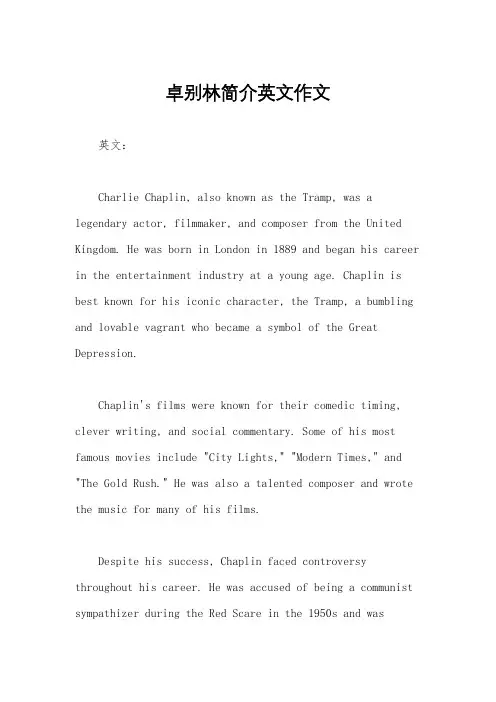
卓别林简介英文作文英文:Charlie Chaplin, also known as the Tramp, was a legendary actor, filmmaker, and composer from the United Kingdom. He was born in London in 1889 and began his career in the entertainment industry at a young age. Chaplin is best known for his iconic character, the Tramp, a bumbling and lovable vagrant who became a symbol of the Great Depression.Chaplin's films were known for their comedic timing, clever writing, and social commentary. Some of his most famous movies include "City Lights," "Modern Times," and "The Gold Rush." He was also a talented composer and wrote the music for many of his films.Despite his success, Chaplin faced controversy throughout his career. He was accused of being a communist sympathizer during the Red Scare in the 1950s and waseventually forced to leave the United States. However, he continued to make films and was awarded an honorary Oscar in 1972 for his contributions to the film industry.Overall, Charlie Chaplin's legacy as a filmmaker and entertainer has had a lasting impact on popular culture. His films continue to be beloved by audiences around the world and his influence can be seen in the work of many modern filmmakers.中文:查理·卓别林,也被称为小流浪汉,是英国一位传奇的演员、电影制片人和作曲家。
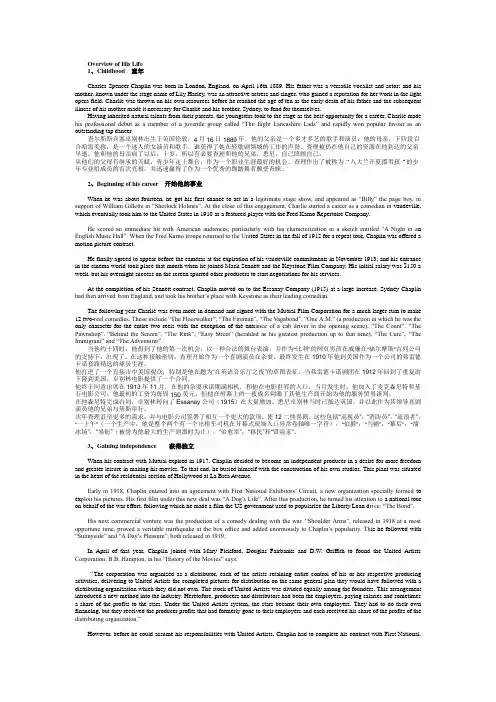
Overview of His Life1、Childhood 童年Charles Spencer Chaplin was born in London, England, on April 16th 1889. His father was a versatile vocalist and actor; and his mother, known under the stage name of Lily Harley, was an attractive actress and singer, who gained a reputation for her work in the light opera field. Charlie was thrown on his own resources before he reached the age of ten as the early death of his father and the subsequent illness of his mother made it necessary for Charlie and his brother, Sydney, to fend for themselves.Having inherited natural talents from their parents, the youngsters took to the stage as the best opportunity for a career. Charlie made his professional debut as a member of a juvenile group called “The Eight Lancashire Lads” and rapidly won popular favour as an outstanding tap dancer.查尔斯斯宾塞卓别林出生于英国伦敦,4月16日1889年。
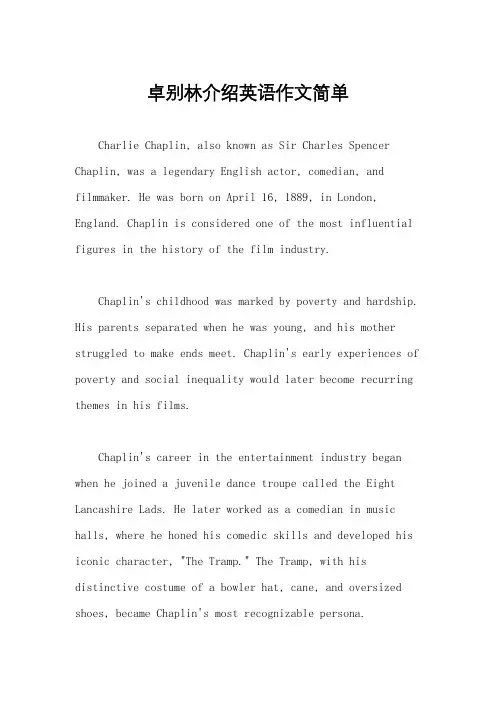
卓别林介绍英语作文简单Charlie Chaplin, also known as Sir Charles Spencer Chaplin, was a legendary English actor, comedian, and filmmaker. He was born on April 16, 1889, in London, England. Chaplin is considered one of the most influential figures in the history of the film industry.Chaplin's childhood was marked by poverty and hardship. His parents separated when he was young, and his mother struggled to make ends meet. Chaplin's early experiences of poverty and social inequality would later become recurring themes in his films.Chaplin's career in the entertainment industry began when he joined a juvenile dance troupe called the Eight Lancashire Lads. He later worked as a comedian in music halls, where he honed his comedic skills and developed his iconic character, "The Tramp." The Tramp, with his distinctive costume of a bowler hat, cane, and oversized shoes, became Chaplin's most recognizable persona.In 1914, Chaplin made his debut in the film industrywith the silent film "Making a Living." He quickly gained popularity with his physical comedy and slapstick humor. Some of his most famous films include "The Kid" (1921), "City Lights" (1931), and "Modern Times" (1936). Chaplin's films often combined comedy with social commentary, addressing issues such as poverty, industrialization, and the struggles of the working class.Chaplin's silent films were accompanied by his own musical compositions, and he later transitioned into making sound films. However, his career faced challenges in the 1940s due to his political views. Chaplin was known for his left-leaning political beliefs and was accused of being a communist sympathizer during the era of McCarthyism. As a result, he faced scrutiny and was eventually forced toleave the United States and settle in Switzerland.Despite the controversies surrounding his personal life, Chaplin's contributions to the film industry cannot be overlooked. He was a pioneer in the development of comedyand brought laughter to millions of people worldwide. His physical comedy, expressive acting, and ability to connect with audiences transcended language barriers.In recognition of his achievements, Chaplin received numerous awards and honors throughout his career. He was awarded an honorary Academy Award in 1972 for his lifetime contributions to cinema. In 1975, Queen Elizabeth II knighted him, and he became Sir Charles Spencer Chaplin.Charlie Chaplin's legacy continues to inspire and entertain audiences to this day. His films remain timeless classics, and his impact on the world of cinema is undeniable. Chaplin's ability to use humor to shed light on social issues and connect with people from all walks oflife is a testament to his genius and enduring influence.。
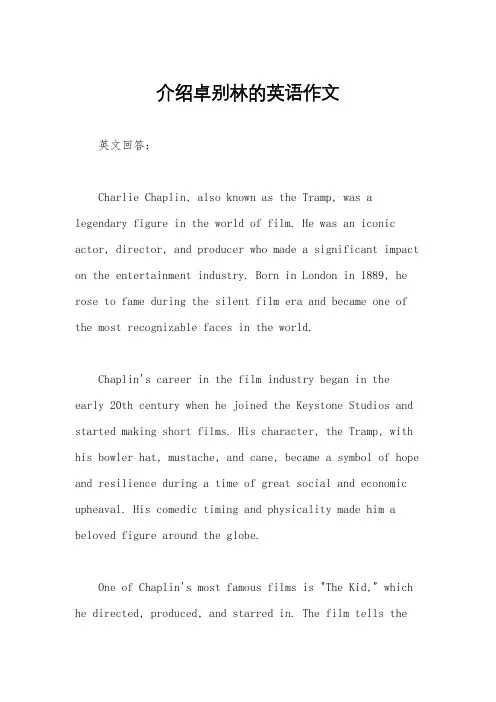
介绍卓别林的英语作文英文回答:Charlie Chaplin, also known as the Tramp, was a legendary figure in the world of film. He was an iconic actor, director, and producer who made a significant impact on the entertainment industry. Born in London in 1889, he rose to fame during the silent film era and became one of the most recognizable faces in the world.Chaplin's career in the film industry began in the early 20th century when he joined the Keystone Studios and started making short films. His character, the Tramp, with his bowler hat, mustache, and cane, became a symbol of hope and resilience during a time of great social and economic upheaval. His comedic timing and physicality made him a beloved figure around the globe.One of Chaplin's most famous films is "The Kid," which he directed, produced, and starred in. The film tells thestory of a tramp who finds and raises an abandoned child.It is a heartwarming and humorous tale that showcases Chaplin's ability to blend comedy with deep emotional resonance. Another iconic film is "City Lights," a romantic comedy that has stood the test of time and is still celebrated for its heartfelt storytelling and brilliant performances.Chaplin's influence extended beyond the world of film. He was also a talented composer and composed the music for many of his films. His creative genius and ability to connect with audiences on a profound level cemented his legacy as one of the greatest entertainers of all time.中文回答:查理·卓别林,也被称为小流浪汉,是电影界的传奇人物。

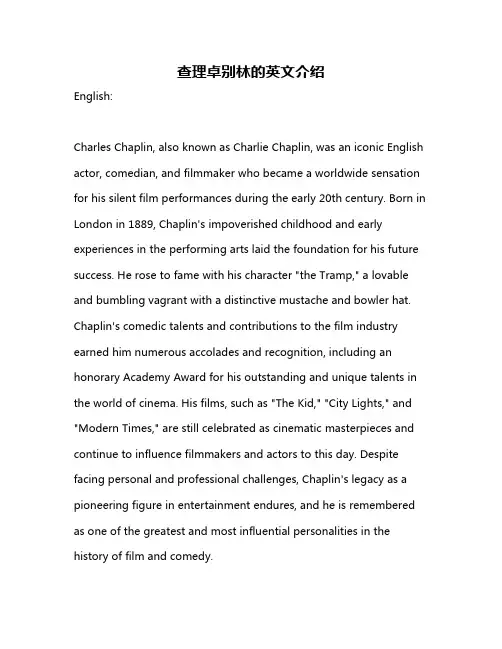
查理卓别林的英文介绍English:Charles Chaplin, also known as Charlie Chaplin, was an iconic English actor, comedian, and filmmaker who became a worldwide sensation for his silent film performances during the early 20th century. Born in London in 1889, Chaplin's impoverished childhood and early experiences in the performing arts laid the foundation for his future success. He rose to fame with his character "the Tramp," a lovable and bumbling vagrant with a distinctive mustache and bowler hat. Chaplin's comedic talents and contributions to the film industry earned him numerous accolades and recognition, including an honorary Academy Award for his outstanding and unique talents in the world of cinema. His films, such as "The Kid," "City Lights," and "Modern Times," are still celebrated as cinematic masterpieces and continue to influence filmmakers and actors to this day. Despite facing personal and professional challenges, Chaplin's legacy as a pioneering figure in entertainment endures, and he is remembered as one of the greatest and most influential personalities in the history of film and comedy.中文翻译:查理卓别林,也被称为查理·卓别林,是一位标志性的英国演员,喜剧演员和电影制片人,在20世纪初因其无声电影表演而成为了全球轰动。
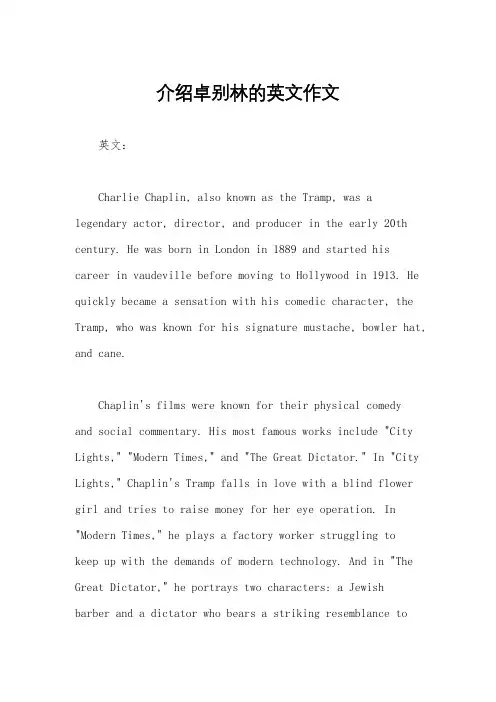
介绍卓别林的英文作文英文:Charlie Chaplin, also known as the Tramp, was a legendary actor, director, and producer in the early 20th century. He was born in London in 1889 and started his career in vaudeville before moving to Hollywood in 1913. He quickly became a sensation with his comedic character, the Tramp, who was known for his signature mustache, bowler hat, and cane.Chaplin's films were known for their physical comedyand social commentary. His most famous works include "City Lights," "Modern Times," and "The Great Dictator." In "City Lights," Chaplin's Tramp falls in love with a blind flower girl and tries to raise money for her eye operation. In "Modern Times," he plays a factory worker struggling tokeep up with the demands of modern technology. And in "The Great Dictator," he portrays two characters: a Jewishbarber and a dictator who bears a striking resemblance toAdolf Hitler.Chaplin's impact on cinema cannot be overstated. He was a pioneer in the industry, helping to shape the way wethink about comedy and storytelling on the big screen. He also paved the way for future filmmakers, inspiring generations of artists to come.中文:查理·卓别林,也被称为小丑,是20世纪早期的传奇演员、导演和制片人。
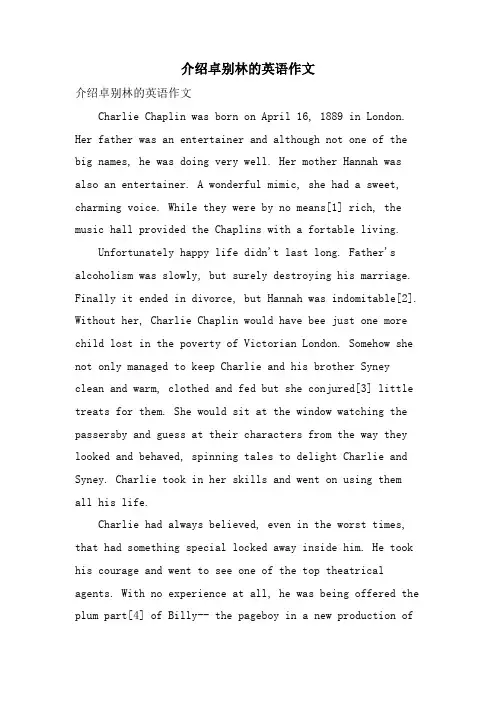
介绍卓别林的英语作文介绍卓别林的英语作文Charlie Chaplin was born on April 16, 1889 in London. Her father was an entertainer and although not one of the big names, he was doing very well. Her mother Hannah was also an entertainer. A wonderful mimic, she had a sweet, charming voice. While they were by no means[1] rich, the music hall provided the Chaplins with a fortable living.Unfortunately happy life didn't last long. Father's alcoholism was slowly, but surely destroying his marriage. Finally it ended in divorce, but Hannah was indomitable[2]. Without her, Charlie Chaplin would have bee just one more child lost in the poverty of Victorian London. Somehow she not only managed to keep Charlie and his brother Syney clean and warm, clothed and fed but she conjured[3] little treats for them. She would sit at the window watching the passersby and guess at their characters from the way they looked and behaved, spinning tales to delight Charlie and Syney. Charlie took in her skills and went on using themall his life.Charlie had always believed, even in the worst times, that had something special locked away inside him. He took his courage and went to see one of the top theatrical agents. With no experience at all, he was being offered the plum part[4] of Billy-- the pageboy in a new production of"Sherlock Holmes". "Sherlock Holmes" opened on July 27,1903 at the enormous "Pavilion Theatre" Charlie seemed to change overnight. It was as if he had found the thing hewas meant to do.It was, by now, 1908, Charlie was nieen and he fell in love. Hetty Kelly was only fifteen. But her parentsquashed[5] the the romance before it really begun-- but the memory of pretty Hetty stayed with Charlie all his life.In 1910, when Karno set off on his yearly American tour, "One of the best pantomime[6] artists ever seen here." They had reached Philadelphia when a telegram arrived and he was being offered the chance to replace a star in the Keystone film pany.Cinema was born in the same year as Charlie thought people still believed it was a passing fad, and would never replace live shows. He was kept hanging about[7] forseveral weeks and he used the time to watch and to learn.He was determined to master this new medium. It offered him the chance of money and suess -- and it would set him free from the unpredictability of live audience.Charlie's first film, released in February 1914, was called "Making a living". Though it didn't satisfy Charlie, the public liked it. After that he had made ten films andhe had learned a lot. The public loved him and distributors were demanding more and more Chaplin films. In anincredibly short time, Charlie had bee a very important man in motion picture...4月16日查理·卓别林出生于伦敦。

卓别林英语作文英文回答:Charlie Chaplin, the iconic English actor, comedian, and filmmaker, is widely renowned as one of the greatest and most influential figures in the history of cinema. His unique blend of physical comedy, social commentary, and heartwarming storytelling left an indelible mark on the art form and continues to entertain and inspire audiences to this day.Chaplin was born in London, England, in 1889. His childhood was marked by poverty and hardship, but he discovered a passion for performing at an early age. In his early teens, he joined a traveling music hall troupe, where he honed his skills in pantomime and stage comedy.In 1913, Chaplin signed a contract with the Keystone Film Company in the United States, and it was there that he created the iconic character that would bring him globalfame: the Tramp. The Tramp, with his bowler hat, oversized shoes, and mustache, was a hapless and endearing figure who reflected Chaplin's own experiences of poverty and social injustice.Chaplin's films often explored themes of class conflict, poverty, and the human condition. His masterpiece, "City Lights" (1931), tells the story of a penniless tramp whofalls in love with a blind flower girl. The film is a poignant and heartwarming exploration of love, compassion, and the human spirit.Chaplin was also a vocal critic of fascism and war. His film "The Great Dictator" (1940) satirizes the rise ofAdolf Hitler and fascism, and it remains one of the most powerful and effective anti-war films ever made.Chaplin's work has been praised for its technical brilliance, its social commentary, and its enduring emotional resonance. He was a master of physical comedy,and his films are filled with iconic moments that have become part of the collective cultural consciousness. Hisfilms have also been credited with helping to establish the United States as a major center of film production.Chaplin received numerous awards and accolades throughout his career, including an Honorary Academy Awardin 1972 for his "incalculable contribution to making motion pictures the art form of this century." He is widely regarded as one of the most important and influentialfigures in the history of cinema, and his work continues to be celebrated and enjoyed by audiences around the world.中文回答:查理·卓别林,这位标志性的英国演员、喜剧演员和电影制作人,被广泛认为是电影史上最伟大、最有影响力的几位人物之一。
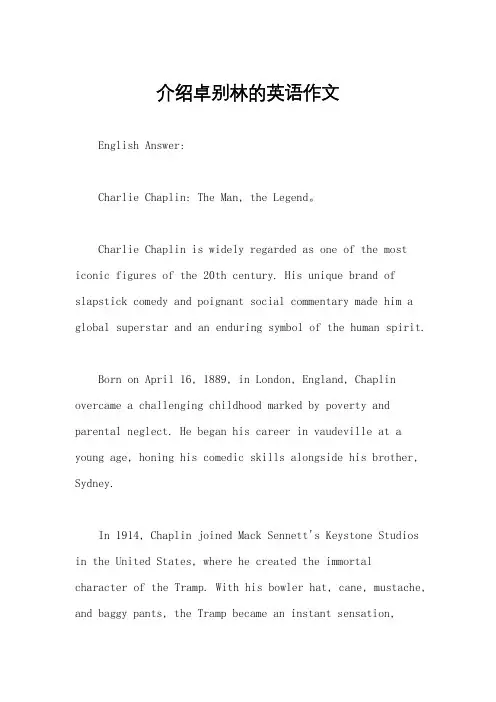
介绍卓别林的英语作文English Answer:Charlie Chaplin: The Man, the Legend。
Charlie Chaplin is widely regarded as one of the most iconic figures of the 20th century. His unique brand of slapstick comedy and poignant social commentary made him a global superstar and an enduring symbol of the human spirit.Born on April 16, 1889, in London, England, Chaplin overcame a challenging childhood marked by poverty and parental neglect. He began his career in vaudeville at a young age, honing his comedic skills alongside his brother, Sydney.In 1914, Chaplin joined Mack Sennett's Keystone Studios in the United States, where he created the immortal character of the Tramp. With his bowler hat, cane, mustache, and baggy pants, the Tramp became an instant sensation,embodying the struggles and resilience of the working class.Chaplin's films transcended mere entertainment. He used his platform to advocate for social justice and human rights. Films such as "The Kid" (1921), "Modern Times" (1936), and "The Great Dictator" (1940) showcased his keen eye for social ills and his unwavering belief in the powerof compassion.Beyond his acting, Chaplin was a prolific writer, director, and composer. He pioneered innovative cinematic techniques, including the use of close-ups and trick photography. His films were a testament to his artistic vision and his ability to connect with audiences on an emotional level.In his later years, Chaplin faced political persecution during the McCarthy era. He was accused of communist sympathies and was forced to leave the United States. He eventually settled in Switzerland, where he continued to work until his death on December 25, 1977.Charlie Chaplin's legacy lives on. His films continue to entertain and inspire audiences worldwide. He is remembered as a master of comedy, a social activist, and a true cinematic icon. His work remains a timeless testament to the human condition and the enduring power of art.Chinese Answer:查理·卓别林,一个人,一个传奇。

关于喜剧演员卓别林介绍的英语作文全文共3篇示例,供读者参考篇1The Legendary Charlie Chaplin: A Cinematic Genius and a Figure of HopeCharlie Chaplin, a name that has become synonymous with the art of silent film and the enduring power of physical comedy. Born on April 16, 1889, in London, England, Chaplin's life was a remarkable journey from poverty and hardship to global fame and artistic acclaim. As a student, I have always been captivated by his ability to transcend language barriers and touch the hearts of millions with his timeless performances.Chaplin's early years were marked by the harsh realities of poverty. His father, a talented vaudeville performer, struggled with alcoholism, and his mother, a singer, battled mental illness. This tumultuous upbringing instilled in Chaplin a resilience and empathy that would later shape his artistry. At a young age, he took to the stage, performing in music halls and theaters, honing his skills and developing his unique comedic style.It was during his time with the Fred Karno comedy troupe that Chaplin truly found his niche. His iconic character, the "Little Tramp," was born – a downtrodden yet endearing figure, clad in a tattered suit, oversized shoes, and a distinctive mustache. This character embodied the struggles and aspirations of the common man, resonating with audiences across the globe.Chaplin's arrival in Hollywood in 1913 marked the beginning of a legendary career that would span decades. His first film appearance in the 1914 comedy short "Making a Living" was a modest start, but it laid the foundation for his meteoric rise. With each subsequent film, Chaplin's reputation grew, and his popularity soared.One of his most celebrated works, "The Kid," released in 1921, showcased Chaplin's remarkable ability to blend humor and pathos. The film's poignant storyline, which follows the Little Tramp's chance encounter with an abandoned child, tugged at the heartstrings of audiences worldwide. Chaplin's performance was a masterclass in physical comedy, evoking laughter and tears in equal measure.As the era of silent films drew to a close, Chaplin seamlessly transitioned into the world of talkies with his 1940 masterpiece, "The Great Dictator." This satirical comedy, in which he playedboth a Jewish barber and the dictator Adenoid Hynkel, was a daring and bold statement against the rise of fascism and antisemitism. Chaplin's brilliant parody of Adolf Hitler and his poignant plea for peace and humanity resonated profoundly, cementing his status as a true artist and social commentator.Throughout his career, Chaplin remained a fierce advocate for artistic freedom and social justice. His films often tackled complex themes, exploring the plight of the working class, the dangers of unchecked power, and the importance of human dignity. His unwavering commitment to his craft and his principles earned him both admiration and criticism, but he never wavered in his pursuit of truth and artistic expression.Perhaps Chaplin's most enduring legacy lies in his ability to bring joy and laughter to audiences around the world. His films transcended cultural and linguistic barriers, connecting with people on a universal level. The Little Tramp, with his endearing clumsiness and unwavering optimism, became a symbol of hope and resilience, reminding us that even in the darkest of times, there is room for laughter and humanity.As a student, I am constantly reminded of the power of art to inspire, educate, and unite. Chaplin's life and work serve as a testament to the transformative potential of cinema and theenduring impact of a single individual's vision. His films continue to captivate audiences, inspiring new generations of artists and thinkers to embrace their creativity and use their voices to bring about positive change.In a world often consumed by conflict and division, Chaplin's message of unity and compassion remains as relevant as ever. His ability to find humor in the most trying circumstances and to shine a light on the struggles of the marginalized has left an indelible mark on the cinematic landscape and the collective consciousness of society.As I reflect on Chaplin's extraordinary journey, I am filled with awe and admiration. From his humble beginnings to his status as a cultural icon, his life serves as a powerful reminder of the transformative power of perseverance, dedication, and artistic vision. Chaplin's legacy extends far beyond the realm of cinema; it is a testament to the enduring spirit of creativity, resilience, and the human capacity for empathy and understanding.In the end, Charlie Chaplin was more than just a comedic genius – he was a visionary artist, a social commentator, and a beacon of hope for countless individuals around the world. His films continue to inspire and delight, reminding us of theuniversal language of laughter and the unifying power of art. As a student, I am grateful for the opportunity to study and appreciate his extraordinary body of work, and I am forever inspired by his unwavering commitment to using his art as a catalyst for positive change.篇2The Immortal Tramp: Charlie Chaplin, the Comedy LegendCharlie Chaplin is a true icon of the entertainment world, a comedic genius whose legacy has transcended generations and captured the hearts of audiences worldwide. As a student of film and history, I have been captivated by Chaplin's remarkable life story and his unparalleled contribution to the art of comedy.Born on April 16, 1889, in London, England, Chaplin's early years were marked by poverty and hardship. His childhood was a tumultuous one, with his mother's mental illness and his father's absence forcing him and his brother to endure the harsh realities of life in the slums. It was during these formative years that Chaplin developed his keen observational skills and a deep empathy for the downtrodden, traits that would later become the cornerstone of his iconic character, the Little Tramp.Chaplin's foray into the world of entertainment began at a young age, as he took to the stage in various music hall performances to support his family. It was during these early years that his natural talent for physical comedy and mime was honed, laying the foundation for the legendary career that was to follow.In 1914, Chaplin's life took a pivotal turn when he signed with the Keystone Film Company and made his debut in the world of silent films. It was here that the iconic Little Tramp character was born – a lovable, downtrodden vagabond with a small mustache, baggy pants, and a cane, who captured the hearts of audiences with his endearing charm and poignant social commentary.Chaplin's genius lay in his ability to blend slapstick comedy with poignant social commentary, using his Little Tramp character as a vehicle to explore the complexities of human existence and the struggles of the working class. Films like "The Kid" (1921), "The Gold Rush" (1925), and "The Circus" (1928) not only showcased his impeccable timing and physical prowess but also his deep understanding of human emotions and the power of pathos.One of Chaplin's most celebrated works, "Modern Times" (1936), was a scathing critique of industrialization and the dehumanization of the working class. Through the lens of the Little Tramp, Chaplin masterfully satirized the harsh realities of the modern world while simultaneously eliciting laughter and empathy from his audience. It was a testament to his ability to seamlessly blend comedy with social commentary, a feat that few have been able to match.Beyond his comedic prowess, Chaplin was also a visionary filmmaker who pushed the boundaries of the art form. He was a pioneer in the use of camera techniques, editing, and storytelling, creating a cinematic language that was both innovative and influential. His films were not mere entertainments but works of art that challenged societal norms and explored the depths of the human condition.Chaplin's impact on the world of comedy is immeasurable. He inspired generations of comedians and filmmakers, from Buster Keaton to Jacques Tati, and his influence can still be seen in contemporary comedic works. His ability to transcend language and cultural barriers, to evoke laughter and tears with equal ease, is a testament to the universal appeal of his art.But Chaplin's legacy extends beyond the realm of entertainment. He was a vocal advocate for social justice and a champion of the underdog, using his platform to raise awareness about the plight of the working class and the need for political and social reform. His films were not mere escapism but a mirror held up to society, reflecting the harsh realities of the time while offering a glimmer of hope and resilience.In my studies, I have been particularly drawn to Chaplin's unwavering commitment to his craft and his uncompromising artistic vision. Despite facing numerous obstacles, including political persecution and financial struggles, he remained steadfast in his pursuit of artistic excellence, refusing to compromise his values or dilute his message.As a student of film and comedy, I am constantly in awe of Chaplin's ability to evoke such a wide range of emotions through his minimalist approach. His performances were a masterclass in physical comedy, with every gesture, every movement, every facial expression meticulously crafted to elicit laughter and pathos. His ability to convey complex emotions without uttering a single word is a testament to his profound understanding of the human condition and the power of non-verbal communication.Chaplin's influence extends far beyond the realm of film and comedy. He was a true Renaissance man, a multifaceted artist who excelled in various disciplines, from composing music to writing and directing. His legacy serves as an inspiration to artists of all kinds, reminding us of the power of creativity, perseverance, and unwavering dedication to one's craft.In today's world, where laughter and joy seem fleeting, Chaplin's work serves as a beacon of hope and a reminder of the healing power of comedy. His films continue to resonate with audiences across generations, transcending cultural and linguistic barriers, and reminding us of the universality of human experiences.As a student, I am deeply grateful for the opportunity to study and appreciate the work of such a legendary figure. Chaplin's life and art have taught me invaluable lessons about resilience, creativity, and the power of laughter to bring people together. His legacy inspires me to approach my own pursuits with the same passion, dedication, and unwavering commitment to artistic excellence.In conclusion, Charlie Chaplin was more than just a comedian; he was a visionary artist, a social commentator, and a true humanitarian. His impact on the world of entertainment andbeyond cannot be overstated. Through his iconic Little Tramp character, he gave voice to the voiceless and shined a light on the struggles of the working class, reminding us of the enduring power of laughter and empathy. As I continue my studies and pursue my own creative endeavors, Chaplin's life and work will forever serve as a guiding light, inspiring me to push boundaries, challenge societal norms, and use my art as a force for positive change.篇3The Tramp Who Made the World Laugh: A Look at the Life and Legacy of Charlie ChaplinWhen you hear the name Charlie Chaplin, one image immediately comes to mind - the iconic little tramp with a bowler hat, bamboo cane, and awkward waddle. With his quirky mustache and ill-fitting clothes, this character created an unforgettable presence on the silent film screen. However, behind the comedic genius that brought smiles to millions was a complex man whose life was marked by immense talent, hardship, controversy, and an unwavering passion for his art.Born on April 16, 1889 in London, Charlie Chaplin entered the world in incredibly humble circumstances. His childhood wasclouded by the dark realities of poverty - his father was an unpredictable artist who eventually abandoned the family, while his mother struggled with mental illness and was committed to an asylum when Charlie was just nine years old. With his family life in shambles, the young Chaplin turned to entertaining on the streets of London as a means of survival, singing songs and performing comedy sketches to earn a few coins.It was this harsh upbringing that shaped Chaplin's comedic sensibilities and brought depth to the iconic "Little Tramp" character he later manifested on the screen. The tramp, dressed in tattered clothes and down on his luck, resonated with audiences as he became a symbol of the struggles faced by the impoverished and the perpetual underdog who kept bouncing back from adversity. As film historian Mark Cousins puts it, "The tramp is still magic because he represents human hopes born out of poverty and pain."Chaplin's meteoric rise in the entertainment world began with his introduction to vaudeville at age 10, where he toured with comic opera troupes and quickly developed his skills in physical comedy and pantomime. It was the perfect launchpad for his transition to silent films in 1914, as he joined the KeystoneFilm Company and starred in comedic shorts showcasing his gift for slapstick humor and impeccable comedic timing.However, it wasn't until 1915 that Chaplin stepped into the role that would elevate him to international stardom – his first appearance as the lovable Little Tramp in the film "The Tramp." With his instantly recognizable costume, the little fellow with the toothbrush mustache and signature walk captivated audiences around the world with his ability to find humor and tenderness even in the direst of circumstances. Chaplin's skill in combining slapstick with pantomime and subtle gestures created a depth to his comedy that transcended language barriers and cultural divides.Over the next 25 years, Chaplin churned out dozens of iconic films, each one a masterpiece of physical comedy and social commentary. From "The Kid" (1921), where he played a tendering father figure to an abandoned child, to the satirical "The Great Dictator" (1940) which boldly mocked Adolf Hitler and the rise of Nazism, Chaplin used his comedic talents to explore the human condition and shine a light on societal issues that often went unspoken.Perhaps his most celebrated work was "Modern Times" (1936), a brilliant commentary on the dehumanizing effects ofindustrialization and mass production. With scenes of Chaplin being literally swallowed by the machinations of a factory assembly line, the film captured the anxieties of a rapidly modernizing world while still finding moments of pure hilarity.Beyond his prodigious body of work on the screen, Chaplin was a trailblazer who fought for artistic control and freedom of expression at a time when studios tried to reign in creative talents. His founding of United Artists in 1919, alongside Douglas Fairbanks and others, gave him an independence rarely afforded to filmmakers of that era. Chaplin could craft his films with minimal oversight, infusing them with bold political messages and social critiques that would have been unthinkable under the tight control of major studios.Yet, Chaplin's life was not without immense controversy and hardship. His personal life, marked by multiple marriages and paternity scandals, was often front-page news. Additionally, his left-leaning political views, connections to communist sympathizers, and pacifist stances during World War II led to him being labeled a subversive by the U.S. government during the paranoia of the McCarthyism era. This culminated in Chaplin being denied re-entry into the United States in 1952 while traveling abroad – an event that left the 63-year old iconessentially exiled from the country that had brought him lasting fame.Chaplin spent his final 25 years living as an ex-patriot in Switzerland, occasionally appearing on television and receiving a lifetime achievement award from the Academy in 1972. Even in his twilight years, the "Little Tramp" commanded immense adoration from fans. Upon his death in 1977 at age 88, the world mourned a true cinematic legend and an artist who had brought incomparable joy and laughter to countless lives.Looking at Chaplin's profound legacy nearly 50 years after his passing, it's clear that his impact extends far beyond the comedic realms of cinema. Through the Little Tramp, he gave the world an enduring symbol representing the resilience and hopefulness of the human spirit in the face of adversity. At a time when silent films were considered a fleeting novelty, Chaplin's genius elevated the artform and set a benchmark for physical comedy and storytelling that few have matched.Equally vital was Chaplin's role as a social commentator – his films bravely held a mirror up to society, satirizing authoritarianism, inequality, and the ethical pitfalls of modernity in a way that still resonates today. German poet and playwright Bertolt Brecht spoke for many when he described the brillianceof Chaplin's craft: "The man lie laughed at was capital itself –social injustice, false ethics, hypocrisy. He made a ceaseless battle against this and on behalf of man's laughter."So while the Little Tramp may have been a man of few words, his message of hope, perseverance, and using humor as a tool for social commentary still rings loudly in the 21st century. Whether falling into an ingenious slapstick routine or boldly mocking the forces of fascism and oppression, Charlie Chaplin and his iconic character remain timeless symbols of joy, community, and the transformative power of comedy.。
卓别林英文介绍作文英文:Charlie Chaplin, also known as "The Tramp," was a legendary actor, director, and producer in the early days of Hollywood. He was born in London, England in 1889 and began his career in the entertainment industry at a young age. Chaplin's signature character, The Tramp, was a lovable and comical figure who captured the hearts of audiences around the world. He starred in and directed many iconic films, such as "City Lights," "Modern Times," and "The Great Dictator."Chaplin's talent and creativity extended beyond acting and directing. He was also a gifted composer and wrote the music for many of his films. In addition, he was a pioneer in the film industry, using innovative techniques and technologies to create groundbreaking movies.Despite his success, Chaplin faced many challengesthroughout his life. He was accused of being a communist during the height of the Cold War and was forced to leave the United States. However, he continued to make films and was eventually honored with numerous awards and accolades, including an Academy Award for Lifetime Achievement.Overall, Charlie Chaplin was a true icon of the entertainment industry. His legacy lives on through his timeless films and his influence on future generations of filmmakers.中文:查理·卓别林,也被称为“小流浪汉”,是好莱坞早期的传奇演员、导演和制片人。
[查理卓别林生平简介英语]查理卓别林英语简介(最新3篇)查理·卓别林简介篇一Charlie Chaplin (Charlie Chaplin), born on April 16, 1889 in London, the British film and television actor, director, screenwriter.Charlie Chaplin's first film is "making a living"。
From 1915 began Chaplin began to self-directed, and even served as a producer and editor. Later he joined the company of Espian, and in 1917 produced "immigration" and "An Le Street",in 1918 he and his brother opened his own company in Los Angeles. And in 1919 summoned to Douglas Fairbanks and others. But until 1923, Chaplin only for the company took the first film "Paris a woman." After 1925 the[] "Gold Rush" and 1928 "circus" for Chaplin won the Academy Award.In 1931 because of the "city light" premiere Chaplin came to London, returned to the next year, his next film is 1936 "modern era"。
His backgroundCharlie Chaplin was born on April 16, 1889 in London. His parents were entertainers , who influenced him deeply. While they were by no means rich, the music hall provided the Chaplin with a comfortable living. Unfortunately , their happy life didn't last long. Father's alcoholism was slowly, but surely destroying his marriage. Finally, it ended in divorce and his mother brought him up.His marriageAll his life time , he married four times , but only lived a happy life with his fourth wife.His first wifeMildred HarrisHe get married to her in October 23, 1918. They have a son, but the baby died in three days. They divorced on April 4, 1921.His second wifeLita GreyThey get married in November 26, 1924 and have two sons.In 1928 the two people divorced which made both of them very painful.His third wifePaulette GoddardFrom 1932 to 1940 she and Chaplin had a romantic relationship.She said they married secretly in 1936. but Chaplin in privately say they never formally married so they broke up in 1942.His fourth wifeOona O'NeillThey married on June 16, 1943 when she was only 18 years old and Chaplin was 54 years old. They lead a happy life for the rest of his life,they had eight children.Road of the performing lifeIn 1894, it was the first time that Chaplin appeared on stage in a club in London. At that time he was only five years old.In 1913, he go to America with Karl's mime troupe ,at that time an American director M. Senna discovered his talent, then began his film career.On February 7, 1914, it was the first time he appear in the film “Kid Auto Races at Venice (威尼斯小儿赛车记)” as a duck tramp who wore a bowler hat, a very wide trousers , a pair of big head shoes ,with a stick .This image as the symbol of the Chaplin comedies and popularin Europe and the United States more than 20 yearsIn 1918 Chaplin set up his own company, in Hollywood .From thenon ,he made many famous movies , such as The Gold Rush ,City Lights and Modern Times .In 1940, he took his first sound film The Great Dictator .All his life time ,he made more than 80 films.In 1972, the United States invited Chaplin back to Hollywood and gave him the Oscar Academy Honorary Award (奥斯卡终身成就奖) .In 1977 ,Charlie Chaplin died in Switzerland on Christmas day , at the age of 88.他的背景查尔.卓别林于1889年4月16日出生于伦敦。
Chaplin: The Master of ComedyCharlie Chaplin, a legend in the world of cinema, revolutionized comedy with his unique style and wit. Born in poverty, Chaplin rose to fame with his signature tramp character, a miserable yet charming figure who captivated audiences with his absurd antics and physical comedy. His films, such as "The Gold Rush" and "Modern Times," are timeless classics, renowned for their humor, social commentary, and pathos. Chaplin's influence extends beyond comedy, as he was a talented director, writer, producer, and composer. His legacy remains intact, as his films continue to entertain and inspire generations.卓别林,电影界的传奇人物,以其独特的风格和智慧彻底改变了喜剧的面貌。
他出生于贫困之中,却凭借标志性的流浪汉角色赢得了名声,这个悲惨却又迷人的形象以其荒谬的举止和身体喜剧征服了观众。
他的作品,如《淘金记》和《摩登时代》,都是永恒的经典,以其幽默、社会评论和悲剧色彩而广受赞誉。
卓别林的影响力远不止于喜剧,他还是一位才华横溢的导演、编剧、制片人和作曲家。